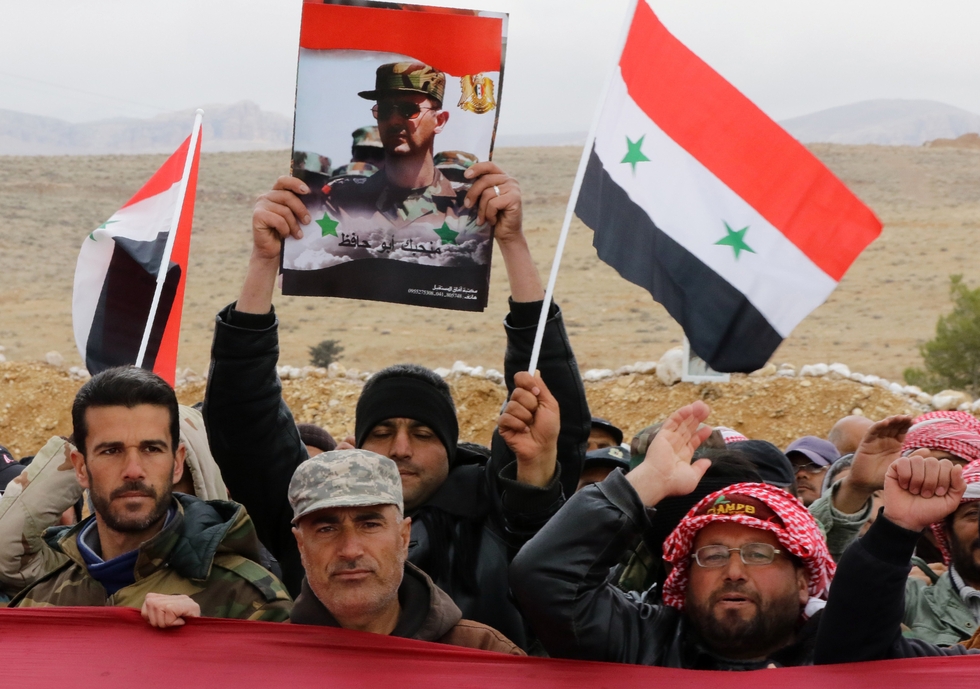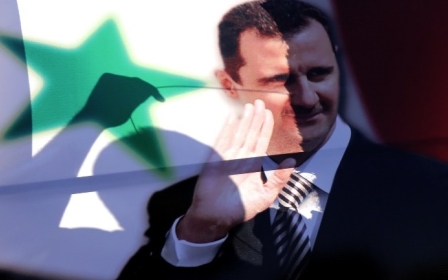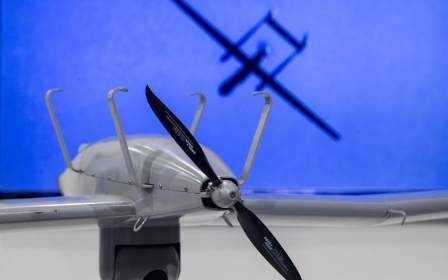How Syria's Assad gave rise to one of the most senior IS leaders

Amr al-Absi, one of the most senior Islamic State (IS) leaders, was killed in an airstrike on 3 March, according to reports on social media and by the SITE Intelligence Group. Al-Absi - better known as Abu al-Atheer - exemplified several key dynamics at work in Syria.
Atheer was among the jihadi-Salafists released by the regime of Bashar al-Assad at the beginning of Syria's uprising in an attempt to make self-fulfilling the regime's claim that the opposition were terrorists, and was also a seminal figure in making Syria so dangerous for journalists that it allowed Assad and IS to shape the coverage as if Syria was a binary choice between them.
Atheer is among the longstanding ultra-extremists who shape and define IS spiritually, and he was crucial in more concrete terms in IS infiltrating and expanding in Syria, particularly by bringing in foreigners who are among the most ideologically driven category of IS members.
Assad's cynical jihadi gambit
Atheer's journey to Islamic militancy was facilitated by his family and the Assad regime.
On 19 July, 2012, a group called Majlis Shura Dawlat al-Islam (MSDI) - the Consultation Council of the Islamic State - raised al-Qaeda's flag over the border crossing at Bab al-Hawa in northern Syria. MSDI was ostensibly loyal to Jabhat al-Nusra, set up (secretly) as a Syrian branch of the Iraq-based IS, which was at that time believed to be ultimately loyal to al-Qaeda, and was led by Atheer's older brother, Firas, who had met with IS's founder, Abu Musab az-Zarqawi, in Taliban Afghanistan. The tension between MSDI and the mainstream rebels boiled over the next month, Firas was killed, and the border retaken by mainstream rebels.
MSDI was the first group to have "Islamic State" in its name and Atheer's group, Katibat Usood al-Sunna (KUS), set up in Homs in February 2012, rather conspicuously used symbols with the words "Islamic State" on them. After Firas was killed, Atheer took the reins of MSDI and the merged it with KUS, later renaming this conglomeration al-Majlis Shura Mujahideen (MSM), not coincidentally the name of one of IS's predecessors. By late 2012, MSM thus controlled networks spanning from Homs to Aleppo - the major theatres of northern Syria.
Atheer was only able to do this because of the Assad regime.
In 2007, some jihadi-Salafists that the Assad regime had sheltered and facilitated in joining IS's predecessor in Iraq began to trickle back into Syria as the US surge turned the tide. Assad diverted some of the jihadis into Lebanon to join Fatah al-Islam, effectively a joint project of Zarqawi and Syrian intelligence, which started a small war in Lebanon that year, benefiting Assad by destabilising a country that had recently freed itself of Syrian occupation. Some of the other jihadis were taken into custody; Atheer was one of them.
At the outset of the Syrian uprising in 2011, Assad released hundreds of jihadis - while continuing to arrest and kill peaceful, secular activists - in a deliberate effort to foment a sectarian war that could position the regime as a guardian of the minorities and a barrier to a terrorist takeover. Atheer was also one of these jihadis, freed from the infamous Sednaya prison in May or June 2011.
By some accounts, this dual conveyer belt - of family and regime - towards militancy goes back even further. Atheer claimed as a "brother" Shaker al-Absi. Shaker is one of the major figures of Levantine jihadism; he is also known to have deep ties to Assad's mukhabarat.
In the summer of 2002, after depositing a dozen or so jihadi leaders in Baghdad in May, Zarqawi moved into Syria to set up the networks that brought the foreign fighters into Iraq - and which operated with the full complicity, indeed the oversight and logistical support, of the Assad regime. While there, Zarqawi planned with Assad for the assassination of a US diplomat in Jordan, which took place in October. Shaker was the assassin. Shaker led Fatah al-Islam in 2007 and was either killed or captured the following year when his use was at an end. Whether Atheer was actually related to Shaker or just used the reference for status is unclear.
What is certain is that Assad's desire for Atheer's release to lead to what might be called "willed blowback" succeeded beyond all expectations.
'Kidnapper-in-chief' and the Caliphate
When MSDI took the border crossing, the video disseminated of the event helped give the impression that the Syrian insurgency writ large was extremist, rather than a tiny number of insurgents, whose leaders were loyal to men and causes beyond Syria. The immediate effect was a three-week closure of the border, which cut off of rebel supplies in the area, and the longer term effect was damage to the rebellion's efforts to gain outside support from the West and its allies.
The distortion in the coverage of Syria got worse when Atheer continued the policy, started by his brother, of kidnapping journalists in northern Syria, earning him the moniker "kidnapper-in-chief" in the Western media. Some victims include James Foley and John Cantlie. With foreign journalists being simultaneously murdered by the regime, it left the regime and IS with a virtual duopoly in media output, and they had the same message: the only opposition to Assad is the jihadis.
A second way in which Atheer benefited the Assad regime was that he was perhaps the most crucial node in IS's network in Syria that allowed IS to hold their ground after the split with al-Qaeda and build their quasi-government, giving Assad the enemies he always wanted.
In April 2013, IS tried to assert in public the theoretical authority it exercised in private over Nusra by subsuming Nusra into a merger headed by IS's leader Abu Bakr al-Baghdadi. IS had sent agents into Syria in August 2011 to set up Nusra, including Nusra's emir, Abu Muhammad al-Jolani, then-IS governor of Ninawa, who linked up with the prisoners released from Sednaya and the IS cells still in Syria from when Assad was running IS jihadis into Iraq to destabilise the post-Saddam government, forming a nationwide network. IS/Nusra intended to embed in the rebellion, win popular support, and then announce itself as al-Qaeda, repairing the damage done to al-Qaeda's brand by IS's brutality in Iraq. But al-Jolani rejected the order.
With the failure of this hostile takeover, al-Baghdadi officially had no forces on the ground in Syria. Except that he did. Al-Baghdadi's deputy, Samir al-Khlifawi, better known as Haji Bakr, a former member of an elite intelligence unit of the Saddam Hussein regime and head of IS's Military Council, its most important institution, had moved into Syria in December 2012 to try to get Nusra and al-Jolani under control, and if that failed to prepare the ground to work around al-Jolani by recruiting Nusrawis.
The tension between IS and Nusra had been evident for a while by the time al-Khlifawi went to Syria. "According to multiple Syrian Salafist and jihadist sources," Charles Lister writes in his book The Syrian Jihad, "in the winter months of 2012, a secret message had been sent from Baghdadi in Iraq to Jolani in Syria insisting that Jabhat al-Nusra publish a statement announcing … its allegiance to" IS. Al-Jolani had not done so.
Al-Jolani had shown dangerous signs of independent thinking - for example showing deference to the concerns of local civilians and delaying the imposition of harsh Islamic law, which IS saw as craven pandering. When al-Jolani intervened to stop IS's powerful spokesman, Abu Muhammad al-Adnani, who had accompanied al-Khlifawi into Syria, from carrying out an attack on the Syrian opposition in Turkey, IS's leaders were sure they had lost control of al-Jolani. Al-Khlifawi went through the motions of negotiations with Nusra's leaders to bring them back into the fold, but his Plan B was already well-advanced.
Employing the tradecraft of the fallen Saddam regime - spies spying on spies and multiple lines of authority - al-Khlifawi had a "track two" in Syria, a network of men and groups loyal directly through him to al-Baghdadi rather than loyal to al-Jolani (who was notionally ultimately loyal to al-Baghdadi). Atheer and the Absi family in Aleppo were the backbone of "track two". When the caliph came to Syria in March 2013, he met Atheer first and received a secret loyalty oath. Atheer even helped al-Khlifawi organise al-Baghdadi's place of abode - a shipping container in northern Aleppo.
Thus, when al-Jolani rejected al-Baghdadi's public order to come to heel, as it was by then expected he would, IS was well-positioned.
Low-level trouble had erupted between MSM and Nusra in January 2013 after MSM struck down a rebel commander and Nusra disowned MSM. As well as kidnappings, Atheer would become notorious for the perpetration of assassinations. Over the summer of 2013, the schism between Nusra and its parent branch hardened. Al-Qaeda ordered IS back to Iraq; IS refused and set about state-building, annexing large numbers of Nusra fighters to help them, a process in which Atheer was vital.
The international brigades
After the IS-Nusra separation, Atheer was the first to publicly switch allegiance to IS. Atheer's group was also key in ensuring that Tarkhan Batirashvili, the much-feared Chechen jihadist known as Abu Omar al-Shishani who was allegedly killed the day after Atheer, lived up to his promise of loyalty to al-Khlifawi. Batirashvili initially expressed some doubts about breaking his pledge of allegiance to al-Jolani. Al-Khlifawi let it be known Batirashvili would be liquidated if he defied IS. Atheer's group was based adjacent to Batirashvili's, west of Aleppo, and as mentioned Atheer was known for conducting assassinations, making the threat believable. Batirashvili publicly joined IS in May 2013.
Batirashvili's military skill has been much-sensationalised, but his real value to IS was always in propaganda, to show IS as a multinational enterprise and to magnetise foreign volunteers. Leaks on Wednesday revealed the names of 22,000 foreign jihadists who have joined IS, many of them Europeans. It was Batirashvili's group in Aleppo that many of the early Euro-jihadists joined, particularly Dutch and Belgians and a core of Brits, setting in place the networks that operate to this day, and it was Atheer that guided this process.
Moreover, internally to Syria, as IS's proto-statelet spread in late 2013 in accordance with al-Khlifawi's plan, Atheer acted as a "roving ambassador across much of northern Syria," advocating and recruiting for al-Baghdadi. Atheer was particularly important in pulling away the foreign fighters from Nusra.
Batirashvili's group formally divided in two in November 2013 after some resisted his demand to swear individual loyalty to IS. Batirashvili left with a pro-IS faction that contained Mohammed Emwazi ("Jihadi John"). Another European jihadist who followed Atheer from Nusra into IS was Abdelhamid Abaaoud, the operational leader of the November 2015 Paris attacks.
A defining voice
Atheer had been one of the loudest promoters the caliphate declaration, before and after, encouraging Muslims to join the project. Undoubtedly a member of IS's Shura Council, its highest political body that can theoretically remove the caliph, Atheer was at one point IS's governor of Aleppo, but that role was taken over by Batirashvili in late 2013.
What Atheer did after that is not quite clear. Atheer was reported in late 2014 as being the head of IS's media council, which is plausible given his role in promoting IS and attracting foreign fighters. Other reports had Atheer being transferred out to Deir Ezzor as a military commander.
Atheer's spiritual importance to IS, beyond his skill in propaganda and recruitment, is also noteworthy. Atheer was known - even by IS's standards - as an extremist. Last October, Nusra's official media outlet released a video entitled, "Years of deception - Who is splitting the ranks?!" Nusra, naturally, exculpated itself of schismatic behaviour and blamed IS, reserving specific wrath for two IS commanders, Atheer being one of them. Atheer is a "perfect case study" of the "breed of takfiris … subscribing to a narrow set of doctrinal tenets" who dominate IS's mid- and upper-tiers and define the group, Michael Weiss and Hassan Hassan write in ISIS: Inside the Army of Terror.
Still, IS is likely to be able to replace Atheer swiftly and with minimal turbulence. The maturity of IS's institutions, to absorb such a loss as Atheer and see the system barely perturbed, should heighten the scepticism that even numerous individual losses at lower levels will undo the caliphate. There would come a time when IS was losing leaders so quickly that it could not adequately replace them, but that would only be during a serious effort to roll back its territorial control and we are some way short of that.
-Kyle Orton is a Middle East analyst and an associate fellow at the Henry Jackson Society. Visit Kyle's blog or follow him on Twitter @KyleWOrton
The views expressed in this article belong to the author and do not necessarily reflect the editorial policy of Middle East Eye.
Photo: Syrian volunteers and their relatives wave the national flag and portraits of President Bashar al-Assad as they celebrate at the end of a paramilitary training conducted by the Syrian army in al-Qtaifeh, 50 kms north of the capital Damascus on 22 February, 2016 (AFP).
Stay informed with MEE's newsletters
Sign up to get the latest alerts, insights and analysis, starting with Turkey Unpacked
Middle East Eye delivers independent and unrivalled coverage and analysis of the Middle East, North Africa and beyond. To learn more about republishing this content and the associated fees, please fill out this form. More about MEE can be found here.





